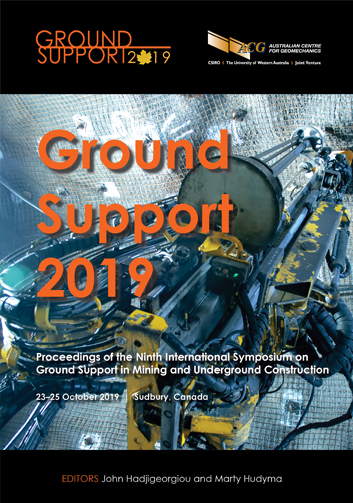Polyester resin injection of dynamic resin and cable bolting systems to improve development efficiency

|
Authors: Roberts, T; Faulkner, D |
DOI https://doi.org/10.36487/ACG_rep/1925_36_Roberts
Cite As:
Roberts, T & Faulkner, D 2019, 'Polyester resin injection of dynamic resin and cable bolting systems to improve development efficiency', in J Hadjigeorgiou & M Hudyma (eds), Ground Support 2019: Proceedings of the Ninth International Symposium on Ground Support in Mining and Underground Construction, Australian Centre for Geomechanics, Perth, pp. 505-518, https://doi.org/10.36487/ACG_rep/1925_36_Roberts
Abstract:
Traditional mechanised resin rockbolting in hard rock underground mines requires the installation of resin capsules into a pre-drilled hole, prior to the rockbolt being spun into a hole to mix the resin and set the bolt in place. In poor rock mass conditions, especially at depth or in highly altered faults and shears, the condition of the holes often deteriorates, as the poor ground around it unravels and falls into the hole. This results in partially or fully blocked holes, that either damages the resin capsule when they are being inserted into the hole, or prevents the resin capsule from being inserted until the hole is entirely cleaned of debris. This deterioration of the hole condition, and continuous need to clean and re-drill holes, also increases the diameter of the hole which in turn affects the continuously mechanically coupled anchorage mechanism of the rockbolt to the rock mass as there is simply not enough resin in the hole to fill the annulus between the bolt and the rock. This results in a large increase to critical heading cycle time and, more importantly, results in the rock reinforcement not performing as per design specification and increases the risk of instability. To overcome the quality control issues with resin bolt installation in poor ground, a single pass drill, install, inject and tension self-drilling resin bolt application was designed and implemented for use in such conditions. This system allows the operator to inject a two-part polyester resin through a self-drilled hollow bolt to mix and fully encapsulate the rock reinforcement. The self-drilling bolt allows for post-injection of the hole after the bolt has been installed into the rock and gives the operator manual or automated control on the amount of resin used to fill the hole, ensuring complete encapsulation and continuously mechanically coupled anchorage to the rock. This allows the reinforcement to work as designed and provide the geotechnical engineer extra quality control confidence in these conditions. The implementation of this single pass resin-bolting system resulted in significant decreases to the resin-bolting cycle time and rockbolt quality control failures. In this paper the design, implementation and embedment into the development cycle will be discussed and the in situ quality control checks used to validate the increase in rockbolt installation quality will be shared.
Keywords: rapid development, quality control, ground support, poor ground, self-drilling resin bolt, geotechnical engineering
References:
Faulkner, D, Stankus, J, Ma, K & Ma, L 2017, Multiple point anchor (MPA), self-drilling, hollow core yielding bolt with injectable J-Lok P resin system for high-stress and squeezing ground conditions, Proceedings of the 51st U.S. Rock Mechanics/Geomechanics Symposium, American Rock Mechanics Association, Alexandria, pp. 533–536.
Watt, G, Roberts, T & Faulkner, D 2018, ‘Single pass drill install and inject self-drilling resin bolt application in poor ground’, Proceedings of the Fourth Australasian Ground Control in Mining Conference, The Australasian Institute of Mining and Metallurgy, Melbourne.
De Zoysa, U & Manoj, H 2018, Dynamic Tested Cement Encapsulated Cablebolt Systems, research report for Oyu Tolgoi LLC, Western Australian School of Mines, Kalgoorlie.
Stankus, J & Ma, K 2018, Comparison of Pumpable Resin, J-Lok P vs Urea-Silicate white paper, Keystone Mining Services, Pittsburgh.
© Copyright 2024, Australian Centre for Geomechanics (ACG), The University of Western Australia. All rights reserved.
View copyright/legal information
Please direct any queries or error reports to repository-acg@uwa.edu.au
View copyright/legal information
Please direct any queries or error reports to repository-acg@uwa.edu.au